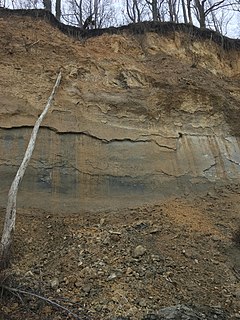Chesapeake Group
 From Wikipedia - Reading time: 5 min
From Wikipedia - Reading time: 5 min
| Chesapeake Group | |
|---|---|
| Stratigraphic range: Neogene | |
 Calvert Formation Exposed at Brownies Beach | |
| Type | Group |
| Sub-units | Old Church Formation, Calvert Formation, Choptank Formation, St. Marys Formation, Eastover Formation, Yorktown Formation, and Chowan River Formation |
| Location | |
| Region | |
| Country | |
The Chesapeake Group is a geologic group in Maryland, Virginia, Delaware, and North Carolina.[1][2][3] It preserves mainly marine fossils dating back to the Late Oligocene through the Pliocene epochs of the Neogene period.[4] This group contains one of the best studied fossil record of Neogene oceans in the world. Professional Paleontologists and amateur fossil hunters alike collect from this group intensely. The Calvert Cliffs stretch the length of Calvert County, Maryland and provide the best continuous stretch of the Calvert, Choptank, and St. Marys Formations. Ward (1985) recommended including the Old Church Formation in this group.[5]
See also
[edit]- List of fossiliferous stratigraphic units in North Carolina
- List of fossiliferous stratigraphic units in Maryland
- List of fossiliferous stratigraphic units in Delaware
- List of fossiliferous stratigraphic units in Virginia
References
[edit]- ^ "Calvert Cliffs Fossils". mgs.md.gov. 2014. Retrieved 24 June 2014.
- ^ "Chesapeake Group | The Delaware Geological Survey". www.dgs.udel.edu. Retrieved 2020-08-14.
- ^ "Miocene bony fishes from the Calvert, Choptank, St. Marys and Eastover Formations, Chesapeake Group, Maryland and Virginia". ResearchGate. Retrieved 2020-08-14.
- ^ "Chesapeake Group | The Delaware Geological Survey". dgs.udel.edu. 2014. Retrieved 24 June 2014.
- ^ Ward, Lauck W. (1985). "Stratigraphy and characteristic mollusks of the Pamunkey Group (lower Tertiary) and the Old Church Formation of the Chesapeake Group; Virginia Coastal Plain". Professional Paper. doi:10.3133/pp1346. ISSN 2330-7102.
- Various Contributors to the Paleobiology Database. "Fossilworks: Gateway to the Paleobiology Database". Retrieved 17 December 2021.
Licensed under CC BY-SA 3.0 | Source: https://en.wikipedia.org/wiki/Chesapeake_Group6 views | Status: cached on April 08 2025 12:57:22↧ Download as ZWI file
 KSF
KSF